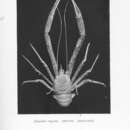en
names in breadcrumbs


Munida rugosa, commonly known as the rugose squat lobster or plated lobster, is a species of decapod crustacean found in the north east Atlantic Ocean and the Mediterranean Sea.
There has been confusion over the nomenclature of certain members of the genus Munida for some time but in 1986, A. L. Rice and Michèle de Saint Laurent examined the literature and specimens in collections and determined that there were four species involved. They determined that the correct names were Munida rugosa (Fabricius, 1775), M. tenuimana G. O. Sars, 1872, M. intermedia A. Milne Edwards & Bouvier, 1899, and M. sarsi Huus, 1935. The first three species occur in both the Atlantic Ocean and the Mediterranean Sea while M. sarsi is found only in the Atlantic.[2] The name M. bamffia was used extensively in the 19th century and early 20th century but it seems to have been used for two species, M. intermedia and M. rugosa. The specific epithet "bamffius" was itself an error as Thomas Pennant was naming his newly described species after the town of Banff in Scotland near where his specimen was found.[2]
Munida rugosa is orange with transverse bands of darker colour on the carapace and abdomen. It is up to 10 centimetres (3.9 in) long but like other members of the genus, it folds its abdomen beneath its cephalothorax. The carapace including the rostrum is about 30 millimetres (1.2 in) long. The carapace has a few spines on the back edge and the rostrum has a single central spine, flanked by two shorter spines above the eyes.[3] The thread-like antennae are slightly shorter than the first pair of appendages which are tipped by long narrow white pincers. The next three pairs of limbs also have white tips and are used for walking. The fifth pair is particularly thin and is usually held underneath the margins of the carapace.[4] The eyes are relatively small in this species and the morphology varies over its range. More southerly specimens are more spiny, have more setae on the abdomen and have longer, more slender limbs.[2]
Munida rugosa is found in the western Mediterranean Sea, around Madeira, in the north eastern Atlantic Ocean, in the North Sea and adjacent continental waters north of 25°N.[1] at depths of up to 150 metres (490 ft), typically in cracks or under boulders.[3]
Gametogenesis is followed by spawning, larval release and larval settling. The eggs are carried in the female's brood patch and the larvae are released at the most favourable season for their survival when there is the most particulate food available.[5] In a study of M. rugosa from the west of Scotland, it was found that 86% of the females carrying embryos had mated with more than one male.[6]
It has been found that some larger males exhibit sexual dimorphism in that their claws become arched rather than being straight. This seems to be a form of sexual selection and it may be that such chela are more able to inflict puncture wounds when males are interacting in competition for females.[7]
Munida rugosa, commonly known as the rugose squat lobster or plated lobster, is a species of decapod crustacean found in the north east Atlantic Ocean and the Mediterranean Sea.
Munida rugosa (Fabricius, 1775) è un crostaceo decapode appartenente alla famiglia Munididae diffuso nel Mediterraneo e nell'Atlantico orientale.[1]
È un anomuro dall'aspetto intermedio tra una piccola aragosta e un granchio: l'addome è ridotto ma più sviluppato che in altri galateoidi come i Porcellanidi, e viene tenuto ripiegato al di sotto del cefalotorace. La lunghezza media del corpo, addome incluso, è di circa 6 cm, anche se può arrivare a 10; il carapace ne misura in genere solo 3.[2][3]
La colorazione è rossastra o color ruggine, caratteristica che ne può causare la confusione con Galathea squamifera. Le due specie possono essere comunque facilmente distinte grazie ai chelipedi, che in M. rugosa possono anche essere quattro volte più lunghi del cefalotorace.[4] Questa specie è inoltre dotata di setole giallastre,[5] e i dattili della chela sono bianchi.[3]
Come le altre specie del genere Munida, M. rugosa presenta due spine sul margine frontale del carapace, e al centro un rostro spiniforme il cui margine non è dentellato; una caratteristica distintiva di questa specie è invece la mancanza di spine sul quarto segmento addominale.[5]
I principali predatori di Munida rugosa sono pesci, sia ossei (gallinelle e carangidi come il sugarello) che cartilaginei (tra cui l'aquila di mare).[6]
È ovipara. Nel Mediterraneo il periodo di maturità per gli esemplari femminili è tra aprile e settembre.[5]
Ha un areale ampio che comprende il Mare del Nord, il Mar Mediterraneo e l'oceano Atlantico fino a Madera.[2] È diffusa lungo le coste delle isole britanniche e il limite nord della sua distribuzione è costituito dalle isole Shetland e dal Sognefjord in Norvegia.[7][2]
Può essere trovata tra i 50 e i 150 m di profondità; predilige i fondali ricchi di detriti, fangosi o sabbiosi,[5] ma è anche comune su scogliere, dove è spesso associato con Serpula vermicularis.[7]
Questa specie è stata descritta da Johan Christian Fabricius nel 1775 con il nome di Pagurus rugosus. I seguenti nomi sono sinonimi di Munida rugosa:[1]
Questa specie è anche nota come Munida bamffia (Pennant, 1777) e Munida bamffica (Pennant, 1777), nomi utilizzati da diversi autori per riferirsi a specie distinte.[1]
Munida rugosa (Fabricius, 1775) è un crostaceo decapode appartenente alla famiglia Munididae diffuso nel Mediterraneo e nell'Atlantico orientale.
Munida rugosa is een tienpotigensoort uit de familie van de Munididae.[1] De wetenschappelijke naam van de soort is voor het eerst geldig gepubliceerd in 1775 door Fabricius.
Bronnen, noten en/of referenties